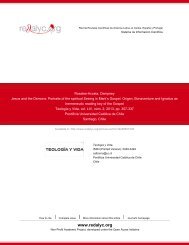A Key Concept in Modern Translation Theory - Redalyc
A Key Concept in Modern Translation Theory - Redalyc
A Key Concept in Modern Translation Theory - Redalyc
Create successful ePaper yourself
Turn your PDF publications into a flip-book with our unique Google optimized e-Paper software.
SERGIO BOLAÑOS CUELLAR<br />
71<br />
very nature does not <strong>in</strong>clude the concept of equivalence, these theories attempt to<br />
deny the nature of translation itself by portray<strong>in</strong>g it as a non-equivalence related<br />
phenomenon/activity. This has been po<strong>in</strong>ted out (Kelletat, Wilss, House) as a major<br />
pitfall <strong>in</strong> this approach. The result of their non-equivalence-based process is not a<br />
translation, but another type of language outcome: a clearly culture-bound<br />
adaptation, an imitation, or some other text-type whose <strong>in</strong>spiration derives from an<br />
already erased (=discarded, omitted, forgotten) SLT. This has been somehow<br />
acknowledged by some authors like H.Vermeer (1990) himself, who prefers to<br />
talk about a culture-bound “Translat”, and not a translation stricto sensu.<br />
One of the most remarkable critics of the notion of equivalence <strong>in</strong> translation<br />
theory is Mary Snell-Hornby (1986). After hav<strong>in</strong>g compared the mean<strong>in</strong>g of<br />
“equivalence” <strong>in</strong> English and German, which the author considers as “nonequivalent”,<br />
she refers to the illusion of equivalence <strong>in</strong> the follow<strong>in</strong>g terms:<br />
“It means that the lexemes equivalent or equivalence exist nowadays <strong>in</strong> English<br />
above all as strictly delimited specialized terms, but at they same time they oscillate <strong>in</strong> the<br />
fuzz<strong>in</strong>ess of common language, that is, quantitatively relative <strong>in</strong> the sense of ‘of similar<br />
significance’, ‘virtually the same th<strong>in</strong>g’. And they entered the English specialized literature<br />
on translation with the latter, blurred, common mean<strong>in</strong>g”(p.14). […]“Altogether, one should<br />
ask oneself whether Äquivalenz or equivalence are suitable terms <strong>in</strong> the science of translation:<br />
on the one hand Äquivalenz –as a scientifically fixed constant for a given goal- is too static<br />
and one-dimensional, and on the other hand equivalence has been watered down up to the<br />
loss of its mean<strong>in</strong>g. Equivalence itself is not equivalent, although the similarity fakes: the<br />
borrow<strong>in</strong>g from the exact sciences has turned out to be an illusion.” (p.15) 6<br />
Juliane House (1997) comments on the argument presented by Snell-Hornby<br />
for turn<strong>in</strong>g down the notion of equivalence:<br />
“Given the relative nature of ‘equivalence’ and the fact that it has clearly noth<strong>in</strong>g<br />
to do with ‘identity’ it is more than surpris<strong>in</strong>g that a polemic attack should have been<br />
directed aga<strong>in</strong>st the concept of equivalence, <strong>in</strong> the course of which an analysis of the<br />
English and German dictionary mean<strong>in</strong>gs of the term ‘equivalence’ was presented (see<br />
6<br />
“Das heisst, dass die Lexeme equivalent bzw. equivalence im heutigen Englisch zunächst<br />
als scharf abgegrenzte Fachterm<strong>in</strong>i existieren, gleichzeitig aber <strong>in</strong> der Unschärfe der Geme<strong>in</strong>sprache<br />
oszillieren, und zwar quantitiv relativierend im S<strong>in</strong>ne ‘of similar significance’, ‘virtually the same<br />
th<strong>in</strong>g’. Und <strong>in</strong> dieser letzten, unscharfen geme<strong>in</strong>sprachlichen Bedeutung g<strong>in</strong>gen sie <strong>in</strong> die englische<br />
Fachliteratur zum Thema Übersetzen e<strong>in</strong>.[…] Insgesamt muss man sich fragen, ob Äquivalenz<br />
bzw. Equivalence als übersetzungswissenschaftliche Term<strong>in</strong>i tauglich s<strong>in</strong>d: e<strong>in</strong>erseits ist Äquivalenz<br />
–als e<strong>in</strong>e für e<strong>in</strong>en bestimmten Zweck wissenschaftlich fixierte Konstante- zu statisch und<br />
e<strong>in</strong>dimensional geraten, und andererseits ist equivalence bis zur Bedeutungslosigkeit verwässert<br />
worden. Selbst die Äquivalenz ist nicht äquivalent, obwohl sie Ähnlichkeit vortäuscht: die<br />
Entlehnung aus den exakten Wissenschaften hat sich als Illusion erwiesen.”
















